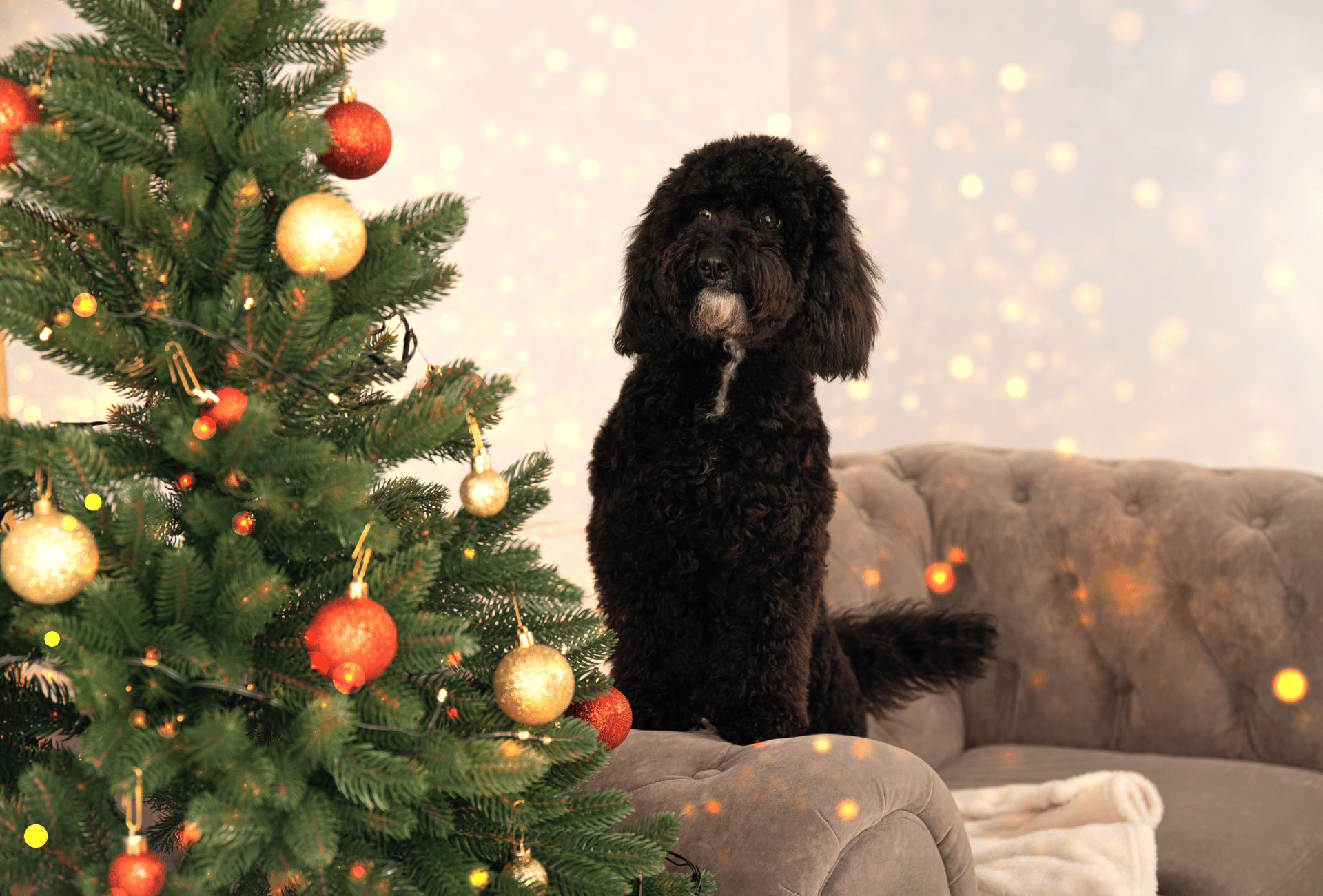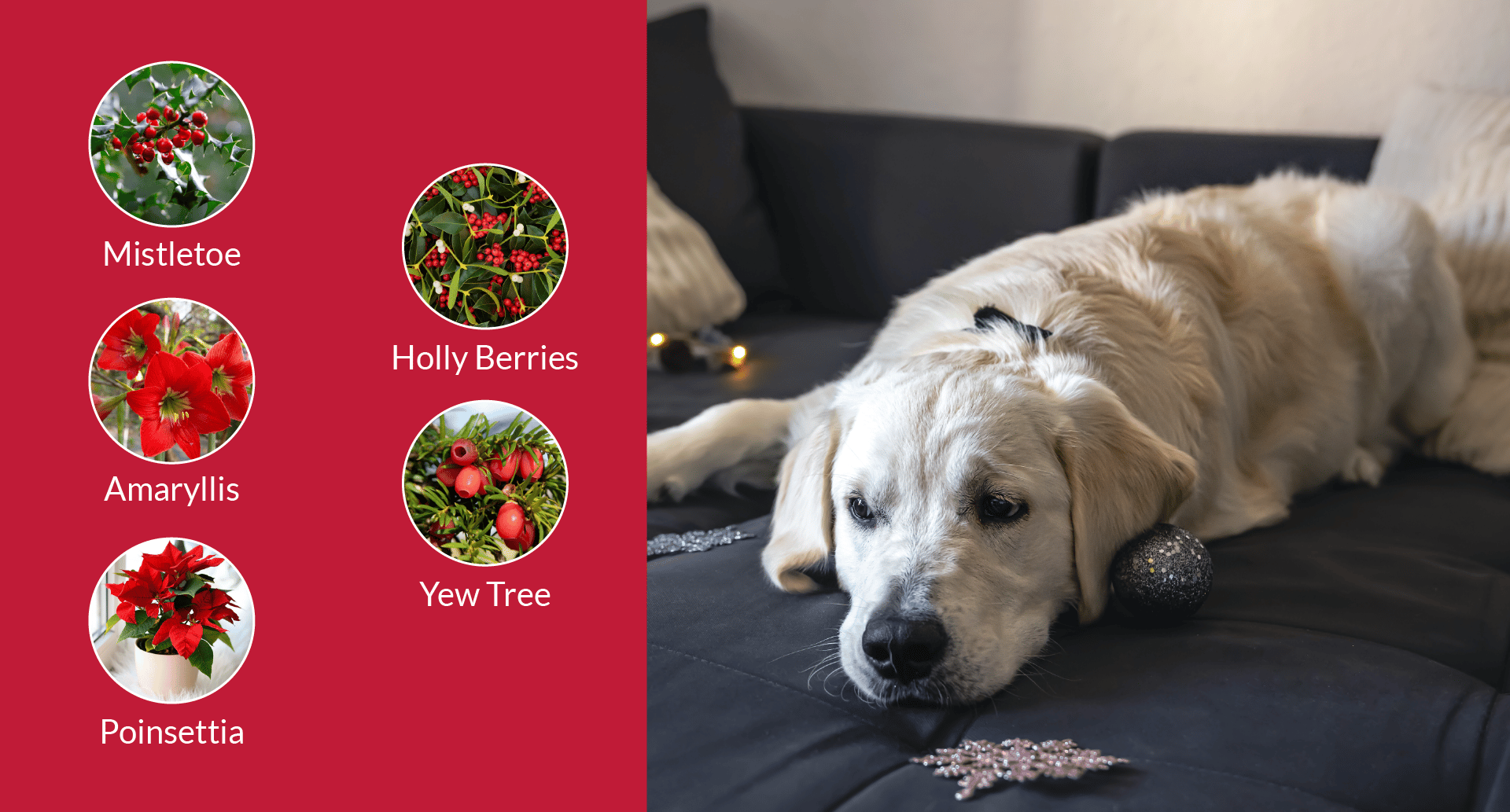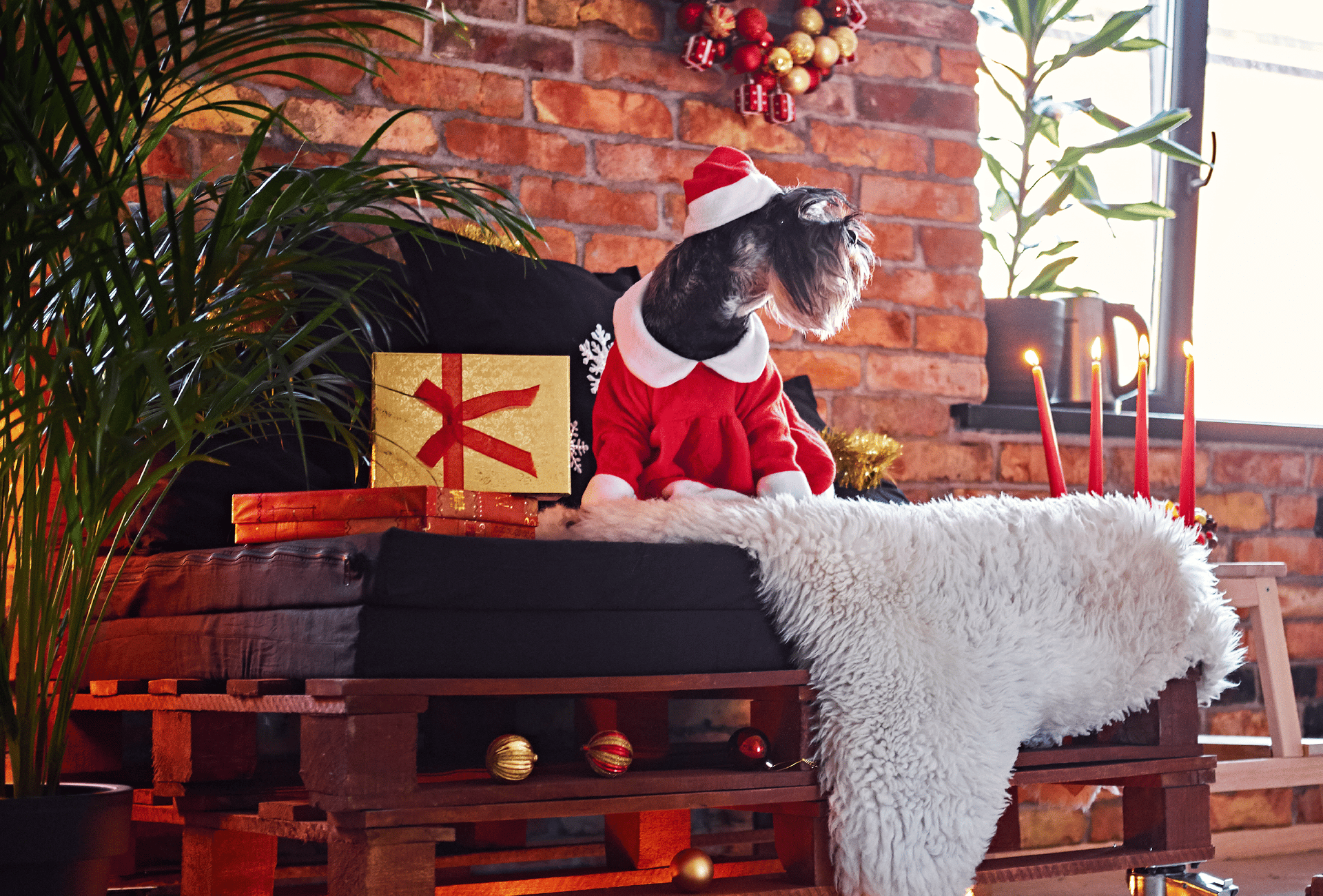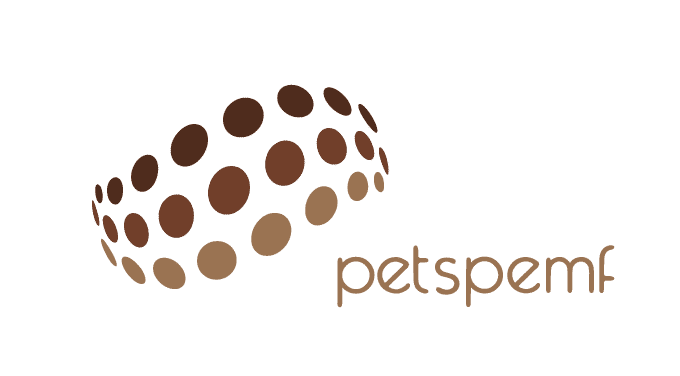It sounds like a cliche, but Christmas Holidays truly are the most beautiful time of the year, at least for us. However, behind the glitz and glam of the ornaments and festive occasions, there are many hidden dangers for pets. This article will discuss the most common holiday-related risks for pets. We will describe the hazards and their solutions. With Christmas so close, there is no time to waste – let’s begin.
1. The Christmas Tree
Obviously, the Christmas tree is the staple of the holiday season. However, the tree is dangerous in various aspects.
Tree Irritation & Toxicity
Fir trees produce oils irritating to the mouth and stomach if ingested. As a result, pets will experience drooling, vomiting, and diarrhea. The evergreen tree needles can also cause stomach upset. Their ingestion may even result in GI tract punctures and obstructions. Additionally, the Christmas tree water often contains fertilizers and preservatives that are toxic to dogs. Even if free from toxins, the water is still dangerous as it is a breeding ground for bacteria and molds.
Solution: Since all of these dangers stem from real, natural Christmas trees, we recommend decorating an artificial one.
Knocking Down The Tree
Cats see the Christmas tree as a tall climbing post, and dogs see it as a really cool and large branch. In both cases, the tree is likely to end up knocked down. When falling, the tree may injure pets.
Solution:
• Anchor the tree to the ceiling or walls
• Weight down the base of the tree
• Wall off the tree with fake presents or pens
• Spray a pet-safe deterrent around the tree.

Tinsel, Ribbons & Angel Hair
Tinsel, ribbons, angel hair, and other ornaments can be found on the tree and elsewhere to boost home décor. As mentioned, such decorations pose a risk if ingested. Your pet can also get tangled and injure itself.
Solution: Play it safe, and do not decorate with tinsels, ribbons, and angel hair if you have a curious pet in the house.
2. Lights & Wires
Chewing cords can result in severe oral burns or even electric shock. When it comes to this holiday danger, dogs are at higher risk than cats, as they are more likely to engage in destructive cord chewing.
Solution:
• Unplug electric decorations when not in use
• Use electrical cord covers and organizers
• Tape down all exposed electric cords
3. Holiday Guests
Spending quality time with friends and family is one of the best things about the winter holidays. However, having guests might be dangerous.
Social Anxiety
The presence of guests can make some pets anxious. This is particularly true for unsocialized pets and pets not used to having people over. Anxiety harms the pet’s well-being and increases the risk of the following danger on our list – escaping.
Solution:
• Do not invite too many people if it makes your pet anxious
• Ask the guests to greet the pet or try to befriend it
• Use calming aids like PEMF pads, CBD oil, or relaxing supplements
Escapism Opportunities
Anxious pets often try to escape. The chances of escaping increase as guests come over and the door frequently opens and closes.
Solution:
• Keep the exits secured and locked
• Make sure your pet is wearing its ID tag
• Microchip your pet.
4. Fireworks & Pyrotechnic Devices
Fireworks and pyroworks are common during festivities. However, they are loud and likely to upset pets, especially ones with noise phobias.
Solution:
• Play music to mask the sound of fireworks and pyroworks
• Ensure a calm and soothing environment for your pet
• Put a PEMF pad in your pet’s bed to promote relaxation
• Use natural calming supplements or anti-anxiety meds
5. Toxic Plants & Flowers
Many plants and flowers used during the winter holidays are toxic or otherwise dangerous for pets. Here are some popular but hazardous plants and flowers:
• Mistletoe: In small amounts, mistletoe ingestion triggers gastroenteritis and abdominal pain. In large amounts, it causes low blood pressure, irregular heart rate, and loss of coordination.
• Holly Berries: Holly is the hallmark of Christmas. However, its berries are toxic and, if ingested, cause severe irritation of the GI tract. In more severe cases, they can also trigger head shaking.
• Amaryllis: Contains a substance called lycorine which is toxic to pets. The most dangerous part of the plant is the bulb.
• Poinsettia: The milky white sap of this flower causes drooling, nausea, vomiting, and diarrhea.
• Yew Tree: All parts of the yew tree are extremely toxic to pets, causing vomiting, drooling, diarrhea, impaired breathing, blood pressure, and heart rate changes, dilated pupils, and tremors & seizures.
Solution: The safest option is to avoid decorating with these plants and flowers. You can use fake decorations or pet-friendly options.

6. Dangerous Foods & Beverages
Foods and beverages are another holiday hazard. Some foods are directly toxic to dogs and cats, while others cause digestive upsets and intestinal injuries.
• Bones & Skin: Bones, especially poultry bones, are a choking risk and can also puncture the intestines. Meat skin, while delicious, is fatty and heavily seasoned, meaning it can cause pancreatitis or stomach upset.
• Unbaked Bread Dough: The yeast in raw dough rises in the stomach and causes bloating. Then, it ferments, resulting in alcohol poisoning.
• Chocolate & Candies: Chocolate is toxic to dogs and cats. Candies with raisins and xylitol (a commonly used sweetener) are toxic to dogs.
• Table Scraps: Table scraps are a huge risk for pets. Even if they do not contain toxic ingredients, they are still fatty, seasoned, or simply hard to digest.
• Alcoholic Beverages: Alcohol is toxic to both dogs and cats.
Solution:
• Ask the guests not to feed your pet
• Give the guests pet treats if they want to interact with your dog/cat
• Don’t leave your pet unsupervised around food
• Remove the food from the table once the meal is over
• Store the leftovers out of your pet’s reach
• Safely dispose of the trash or use pet-proof trash cans
7. Ice Melt & Antifreeze
While not directly related to the holidays, ice melt and antifreeze are winter-linked and, therefore, worth mentioning.
Ice Melt
Ice-melting agents and rock salt can cause chemical damage to the pet’s paws. Also, if ingested, they may result in irritation or even intoxication, based on the type of ice-melting agent.
Solution:
• Use pet shoes or boots when leaving the house
• Supervise your pet, and do not let it lick the ice
Antifreeze
Antifreeze (ethylene glycol) is highly toxic to pets. It has a sweet taste that makes it tempting for pets (dogs more likely than cats) to lick. Once ingested, it causes kidney damage and can be lethal.
Solution:
• Keep antifreeze out of your pet’s reach
• Use propylene instead of ethylene glycol
8. Pet Toys & Batteries
Other pet hazards are toys and batteries.
Pet Toys
Guests may bring pet toys as Christmas gifts. However, if those pet toys are not specific to your pet’s needs, they pose a risk. For example, giving a small toy to a large dog is a choking hazard.
Solution:
• Double-check your pet’s gift toys before letting them play
• Supervise your pet during playtime
• Inspect the toy from time to time and discard it if damaged.
Batteries
Batteries can be found everywhere – from children’s toys to greeting cards. They are dangerous for dogs on several levels. If swallowed whole, they can cause an obstruction.
If chewed and punctured, the caustic substances from the batteries leak, causing chemical burns. Plus, some batteries contain heavy metals (zinc, mercury, lead) that are toxic to pets.
Solution: Do not use battery-operated toys and items around your pet to prevent battery-related accidents.
9. Christmas-Themed Pet Apparel
Last but not least, we must note the dangers associated with Christmas-themed pet apparel. Pet sweaters, bow ties, and antlers are fun but not necessarily safe. Loose threads can be swallowed, broken pieces pose choking danger, and some materials are irritating or simply uncomfortable.

Solution: Ensure the apparel is safe for your pet and it feels comfortable to wear it. If your pet does not like being dressed up, let it be – it sure looks cute and handsome even without the themed sweater and reindeer antlers.
Conclusion
All in all, there are many holiday-related hazards for pets. The good news is that you can prevent them or at least reduce the risks with careful planning. Just in case, we suggest having your vet’s number on speed dial. It is also a good idea to memorize the numbers of the local Pet Poison Control and some nearby emergency clinic. With that being covered, Happy Holidays to you, and safe & stress-free holidays to your beloved furry friends.
References:
- Singh R. Electrocution in a pup: a case report. Research Gate, 2021
- ElleVet Sciences. The Use of ElleVet Sciences Calm and Comfort Acute Strength CBD+CBDA Chews for Anxiety-Inducing Events in Dogs. 2020
- Gahwiler S, Bremhorst A, Toth K, Riemer S. Fear expressions of dogs during New Year fireworks: video analysis. Scientific Reports, 2020
- Gaynor JS, Hagberg S, Gurfein TB. Veterinary applications of pulsed electromagnetic field therapy. Volume 119, August 2018, Pages 1-8
- Rover. Are candles bad for dogs? 2022
- Dircks B, Niedorf F, Mischke R, Kietzmann M. Ethylene glycol poisoning in a dog: case report. Research Gate, 2007
- VetsNow. Button batteries pose potentially deadly risk to cats and dogs, a vet warns. 2021

